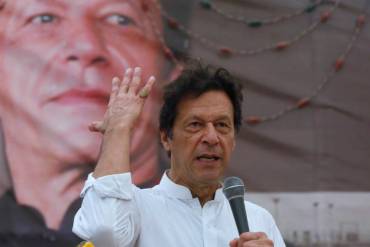In the initial year of the government of Pakistan Tehreek-e-Insaf (PTI), finances declined further with budget deficit soaring to Rs3.45 trillion or 8.9% of the volume of a national economy owing to its utter failure to improve revenues and control expenses.
Formal figures published by the Ministry of Finance on Tuesday verified that the Imran Khan’s government surpassed its budget deficit mark by 82% which held at Rs3.444 trillion in the fiscal year 2018-19. The budgetary deficit point was merely Rs1.9 trillion.



Source: News18
In terms of the volume of the national economy, the 8.9% deficit was the highest in the past 8 years. As per finance ministry data, in total terms, it was the highest-ever shortfall that even broked last year’s record of Rs2.3 trillion.
The unpleasant results have made the 2019-20 budget inappropriate within two months of its endorsement by the National Assembly. This means the government can also fail to deliver the promises that it made with the International Monetary Fund (IMF) under the $6-billion agreement.
The budget shortfall in the initial year of the PTI administration was more detrimental than last years of the Pakistan Peoples Party (PPP) and Pakistan Muslim League-Nawaz (PML-N) regimes. The past governments spend more in their last yeas than in the initial ones.
In 2011-12, the second last year of the PPP government, the budget deficiency was equal to 8.8% of GDP, which later came down to 8.2% in PPP’s last year. Plus, the PML-N left the budget deficit of 6.6%while leaving the government in the year 2017-18.
Notwithstanding Prime Minister’s austerity measure, the PTI government has failed to hold its expenses and heighten revenues. Besides, the tax collections figures depict that people do not trust the PTI government with their capital.
Although the government spent around more than 20% this year, its total revenues were 6% lower than the previous year. As per the finance ministry, 80% of the budget around Rs3.23 trillion was consumed by the defence and debt!
The expenses of federal and provincial governments reached at Rs8.34 trillion in the last financial year, and total wealth stood at Rs4.9 trillion.
Although the government announced two mini budgets in the last fiscal year and enhanced the prices of petroleum goods, the deficit was much higher than the government expectations.



Source: Financial times
Pakistan has also received a net Rs416 billion in external loans and Rs3 trillion in domestic loans in the last financial year. Total foreign loans reached Rs1.4 trillion.
Pakistan has pledged to constantly turn the primary deficit into a surfeit, under the International Monetary Fund (IMF) $6-billion bailout package. In this year, the government is bound to lessen the primary deficit.
This will entail extensive endeavours to intensify tax revenues and curtail non-interest expenses.
To our utter dismay, The FBR’s collection held at Rs3.829 trillion around Rs13 billion less than the accumulation of the Nawaz Sharif government.
Although the government has pledged to improve the FBR’s tax incomes to 13.1% of GDP in the ongoing fiscal year under the umbrella of IMF deal, it now appears improbable.
The ongoing situation of the economy is the result of the wrong policies of the state bank and other financial institutions. In the coming months, Pakistan aslo has to face FATF meeting; hopefully, the government would take pragmatic measures to improve the situation.















